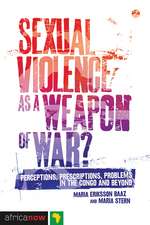Violence and Resilience in Latin American Cities
Editat de Kees Koonings, Dirk Kruijten Limba Engleză Paperback – 14 noi 2015
Featuring much original fieldwork across a broad array of case studies, this cutting edge volume focuses on questions not only of crime, insecurity and violence but also of Latin American cities' ability to respond to these problems in creative and productive ways.
| Toate formatele și edițiile | Preț | Express |
|---|---|---|
| Paperback (1) | 158.64 lei 6-8 săpt. | |
| ZED BOOKS – 14 noi 2015 | 158.64 lei 6-8 săpt. | |
| Hardback (1) | 507.90 lei 6-8 săpt. | |
| ZED BOOKS – 14 noi 2015 | 507.90 lei 6-8 săpt. |
Preț: 158.64 lei
Preț vechi: 183.93 lei
-14% Nou
Puncte Express: 238
Preț estimativ în valută:
30.37€ • 31.25$ • 25.60£
30.37€ • 31.25$ • 25.60£
Carte tipărită la comandă
Livrare economică 01-15 martie
Preluare comenzi: 021 569.72.76
Specificații
ISBN-13: 9781780324562
ISBN-10: 1780324561
Pagini: 224
Dimensiuni: 127 x 229 x 10 mm
Greutate: 0.3 kg
Editura: ZED BOOKS
Colecția Zed Books
Locul publicării:London, United Kingdom
ISBN-10: 1780324561
Pagini: 224
Dimensiuni: 127 x 229 x 10 mm
Greutate: 0.3 kg
Editura: ZED BOOKS
Colecția Zed Books
Locul publicării:London, United Kingdom
Cuprins
1. Urban Fragility and Resilience in Latin America: Conceptual Approaches and Contemporary Patterns - Kees Koonings and Dirk Kruijt
2. Exclusion, Violence and Resilience in Five Latin American Megacities: A Comparison of Buenos Aires, Lima, Mexico City, Rio de Janeiro and São Paulo - Dirk Kruijt and Kees Koonings
3. Caracas: From Heaven's Branch to Urban Hell - Roberto Briceño-León
4. Bogotá: Countering Violence with Urban Government - Alan Gilbert
5. San Salvador: Violence and Resilience in Gangland - Wim Savenije and Chris van der Borgh
6. San José: Urban Expansion, Violence and Resilience - Abelardo Morales Gamboa
7. Kingston: Violence and Resilience - Rivke Jaffe
8. Santo Domingo: Criminogenic Violence and Resilience - Lilian Bobea
2. Exclusion, Violence and Resilience in Five Latin American Megacities: A Comparison of Buenos Aires, Lima, Mexico City, Rio de Janeiro and São Paulo - Dirk Kruijt and Kees Koonings
3. Caracas: From Heaven's Branch to Urban Hell - Roberto Briceño-León
4. Bogotá: Countering Violence with Urban Government - Alan Gilbert
5. San Salvador: Violence and Resilience in Gangland - Wim Savenije and Chris van der Borgh
6. San José: Urban Expansion, Violence and Resilience - Abelardo Morales Gamboa
7. Kingston: Violence and Resilience - Rivke Jaffe
8. Santo Domingo: Criminogenic Violence and Resilience - Lilian Bobea
Descriere
Featuring original fieldwork across a broad array of case studies, this cutting edge volume focuses on questions not only of crime and insecurity, but also of Latin American cities' ability to creatively and productively respond to these problems.
Notă biografică
Kees Koonings is associate professor of development studies on the Faculty of Social Sciences at Utrecht University and professor of Brazilian studies at the University of Amsterdam. Dirk Kruijt is professor emeritus of development studies on the Faculty of Social Sciences at Utrecht University.
Recenzii
“Combining deep on-the-ground knowledge, clear writing, and balanced political and social analysis, this indispensable book throws new light on one of the most puzzling and seemingly intractable issues of twenty-first century Latin America.”
“An important collection that calls attention not only to the fracture and fragility of Latin American cities, but to their resilience in responding to endemic violence and inequality. A valuable contribution sure to be embraced by scholars and students.”
“This crucially important volume focuses on the hope that is present in grassroots organizations, new forms of governance, and other nascent forms of resistance in the world's most violent urban spaces. . . . A volume with important policy implications for the development of urban spaces in Latin American and beyond. Highly recommended.”
“The diversity of case studies and the in-depth research of each of the authors reveal a multi-faceted image of Latin American cities, violence and insecurity, which calls for acknowledging the specific historical and local contexts. The latter is particularly necessary in order to address the structural factors that can reverse the trend of sustained and rising levels of crime and violence, drugs and organized crime that Latin American cities currently experience.”















